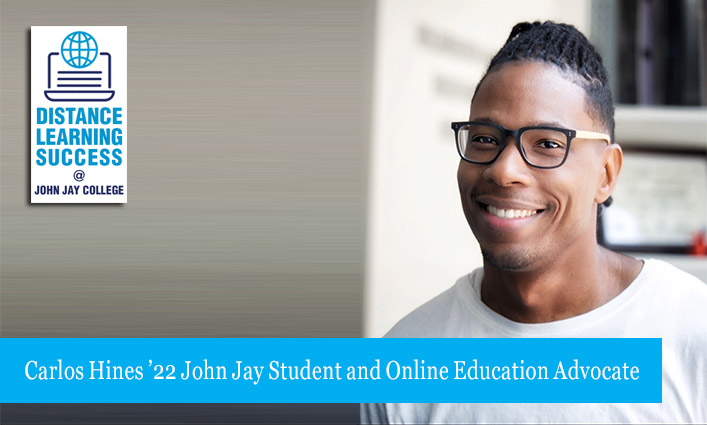
Carlos Hines ’22 understands why many of our students might be nervous about the transition to a distance-learning model, but he’s confident that it’s a challenge our community can handle. “It’s very similar to what transfer students feel when they first step on campus,” says Hines, a Forensic Psychology major who transferred to John Jay. “There’s a sense of feeling a bit lost, a bit confused, and not knowing where anything is.” As a Transfer Representative in John Jay’s Student Council, Hines helps transfer students coming to the College transition and acclimate to the John Jay environment. And, as an online-education advocate, he’s hoping to offer strategies that will help his peers acclimate to the virtual-learning environment. “I’ve taken a number of online courses, at least one course every semester, and it’s really a great way to learn. There’s a lot of benefits to distance learning, for starters you learn to become more organized, proactive, and strategic in your approach to learning. And, you learn to communicate effectively. I know that distance learning is new to a lot of John Jay students, but I also know that it's something they’ll learn to navigate and do successfully.”
“There’s a lot of benefits to distance learning, for starters you learn to become more organized, proactive, and strategic in your approach to learning.” —Carlos Hines
Breaking Assignments Down
One of the best ways to handle an online course load, says Hines, is to divide the workload into smaller projects. “Since distance learning involves a lot of writing and reading, you’re taking in a lot of information and that can be daunting,” explains Hines. “When taking online courses, I break everything down into smaller tasks and spread those tasks out during the course of the day or week, depending on when the assignment is due.” This approach, according to Hines, makes the workload easier to approach, take in, understand, and complete. “Doing this makes it so you’re not overwhelmed and the assignments become totally doable. This strategy works for me every time,” he says.
Using Social Media Skills
“To make the distance-learning experience a little more approachable, I like to think of Blackboard as a higher-level social media website. So, the discussion forum is like your comment section, and you're among friends in that forum. You give your feedback, you like their posts,” says Hines. By looking at Blackboard differently, and drawing parallels with platforms students are familiar with and interact with daily, Hines says, it becomes easier to engage with the virtual-learning platform. “Thinking of it that way lets you wrap your head around it easier.”
“To make the distance-learning experience a little more approachable, I like to think of Blackboard as a higher-level social media website.” —Carlos Hines
Taking Me Time
Another important tip Hines has for his peers: “Take some ‘me time.’ It’s important for students to really take care of themselves, their physical health, and their mental well-being,” says Hines, noting the importance of setting a routine to create a sense of normalcy. “Get up in the morning, brush your teeth, shower, and eat breakfast. You’ll feel reinvigorated and refreshed afterwards and that’s really beneficial for you. You think clearer.” Hines also suggests getting up from your seat often. Whether it’s stretching out your legs, or taking a “coffee break” every couple of hours, it’s important for students to change their scenery and pause when they’re working. “I’ve always done better academically when I take care of myself. You need to get up from your seat regularly; grab a bite to eat; take a break for 30 minutes. Doing that actually makes you more productive, it enables you to focus and makes your work better,” says Hines.
“In each of my distance-learning experiences, the one practice that has always led me to success is prioritizing. You have to determine what’s most important, what’s least important, and what can wait until tomorrow.” —Carlos Hines
Making It Work for You
“In each of my distance-learning experiences, the one practice that has always led me to success is prioritizing. You have to determine what’s most important, what’s least important, and what can wait until tomorrow,” says Hines, acknowledging that students may feel like they have to get all their work done in one day. “You have to make the online-learning process work for you. So if you live with other people, set boundaries as much as you can, tell them: ‘from 12 to 2 p.m. I’m in class.’ This way they know not to bother you,” he suggests. “You don’t like the way your screen looks? Change the layout. Play with all the features on Blackboard, click on everything. And please, ask your professors every question you have. Our professors really want to help you as best as they can, so communicate with them regularly. It’s all about making this distance-learning experience work for you.”



